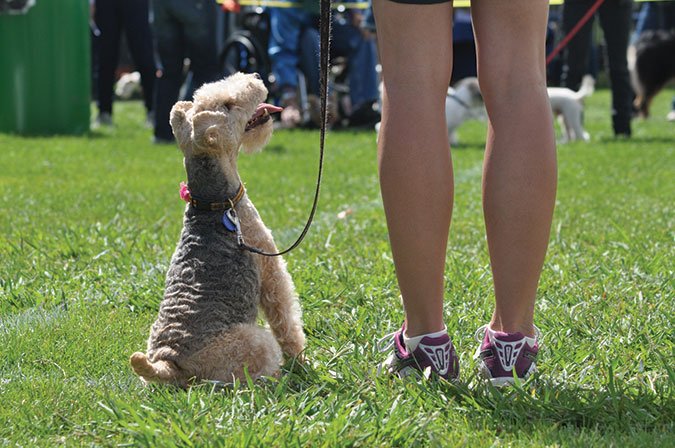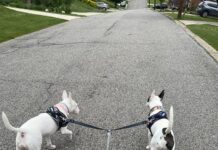LEASH REACTIVITY OVERVIEW
– Avoid dog-dog greetings when your dog is on-leash to prevent frustration aggression.
– Identify the motivation for your dog’s on-leash aggression and address it accordingly.
– Teach yourself and your dog to practice deep breathing to reduce both your stress levels when faced with an approaching dog.
If you hang around with other dog owners, you’ve no doubt heard the same comment I have, over and over again: “My dog is fine with other dogs when he’s off-leash; he’s only dog-aggressive when his leash is on.” You may have even said it yourself.

The reason it’s an often-heard comment is that it’s a common behavior: A lot of dogs who are fine with other dogs when left to their own devices become aggressive if they are leashed when they meet other dogs.
We know that aggression is caused by stress. (See “Understanding Aggression in Dogs,” WDJ October 2010.) Clearly, there is something about being on a leash that a lot of dogs find stressful enough that it prompts aggressive behavior. There are several reasons for this. Let’s take a look at each of them.
Leashes Interfere with Dogs’ Normal Social Interaction
Picture in your mind two dogs meeting and greeting, off-leash. They engage in a social dance – advancing, retreating, moving around each other, sniffing various body parts, giving body language signals intended to keep the interaction civil. Sometimes the movements are slow; sometimes they are quick. If one dog is cautious or fearful of the other, he can retreat as he wishes, using social distance to keep himself safe.
Now picture those same two dogs meeting on-leash. The dance is stilted, inhibited by the restraint of the leash. One dog tries to circle the other, and the leash tangles around his legs. The cautious dog would like to retreat to safety, but knows the leash restricts his movement, and elects to act out his second option to increase distance – a growl and a snap to signal to the other dog to move away – who cannot, because he is leashed. The fight is on.
In the future, the cautious dog will offer a growl and snap before he’s close enough for the other dog to make contact. The best defense is a good offense. Alarmed, owners move away from each other, and the fearful dog’s aggression is reinforced by the increased distance. Behaviors that are reinforced repeat and increase, and the cautious dog’s aggression escalates as he realizes that it’s a successful behavior strategy for him – it keeps other scary dogs away. You now have a leash-aggressive dog. Absent the leash, he still chooses to move away from the other dog – his first behavior choice.
Leash Restraint Frustration
This is the dog who would love to visit with other dogs, on- or off-leash. In fact, you have reinforced his “I wanna go see the other dog!” behavior by frequently allowing him to greet other dogs on-leash, being careful to keep the leash loose, as your instructor showed you in class, to avoid having the leash interfere with the dogs’ normal social interaction. However, sometimes owners of approaching dogs give a clear indication that they don’t want to allow their dogs to greet yours. You politely comply, restraining your dog with his leash to hold him back.
Your dog, who suffers from low impulse control and low tolerance for frustration, becomes highly aroused when his desire to greet the other dogs is thwarted. His frustration and arousal turn into aggression, and your dog is labeled as “reactive.” Absent the leash, he would have happily greeted other dogs without any frustration or aggression.
When the Dog Owner is a Stressor
Stories abound of dogs who are ferocious if the owner is in the room, or holding the leash, yet turn into pussycats when the owner leaves or hands the leash off to someone else. One possibility is that the dog is protecting his owner. Another more likely one is that the owner’s presence gives a fearful dog enough confidence to act aggressively, but the dog shuts down when the owner leaves. Yet a third and perhaps most likely explanation, is that the owner is stressed in anticipation of the dog’s behavior in the proximity of other dogs, as well as other coming events – such as obedience ring competition. The stress of the human is an added stressor for the dog who is well aware of his owner’s emotional distress (they are masters at reading human body language, remember?) and that’s enough to put him over his aggression threshold.

Prior Negative Association with Events that Happened On-Leash
If you ever made the mistake of punishing your dog for inappropriate behavior toward other dogs on-leash, you may have given him a negative association between the leash and the presence of other dogs. Verbal corrections, a jerk on the leash or, horrors, a zap from a shock collar, are all stressors that your dog might now associate with the presence of another dog when he’s on his leash. That added stress can cause him to be aggressive when he otherwise might not have been.
Perhaps he was attacked by another dog when he was on his leash. Attacks can create very strong negative associations; you will often see a dog who is on-leash-aggressive toward a particular breed, type, or color of dog that reminds him of a prior aggressor.
Tightening of the Leash as a Stressor/Trigger
Sometimes introductions seem to be going well until one owner turns to leave, and pulls on the leash to get her dog to come along. Suddenly a fight breaks out for no apparent reason other than the leash tightening.
If things were already a bit tense between the dogs, the tightening of the leash can easily trigger an aggressive outburst. For one thing – it’s a stressor. Imagine if you were engaged in conversation with someone, and someone grabbed your arm – or worse, your shirt collar – and tried to pull you away. Annoying, yes? Well, annoying equals stress – perhaps enough stress to trigger an outburst.
For another, picture two dogs standing nose-to-nose, with some tension between them. Now envision the dog’s body language when his owner pulls back on the leash. The opposition reflex (scientifically named “thigmotaxis”) causes him to lean forward, tighten his muscles and stand a little taller – all of which mimic an assertive, perhaps aggressive body posture in a dog. If the annoyance-stress isn’t enough to trigger aggression in that dog, his offensive body language is likely to trigger an aggressive response from the other dog. You can find an excellent example of this phenomenon on this YouTube video.
What to Do About Leash Aggression
Each of the causes for on-leash aggression has its own remedy. Some require preventative action – proactive steps that reduce the likelihood of future aggression. Others respond well to intervention in the actual moment of potential aggression. They all require that you keep a cool head when you identify possible trouble spots.
Leash interference with normal social interaction:
I make it a pretty strict rule not to introduce dogs while still holding leashes. My dog-to-dog introduction routine involves letting the dogs see each other from a distance and, if all appears copacetic as the dogs near each other, dropping leashes and letting the dogs interact normally, without human interference. If the meeting unravels, we can grab leashes and separate the dogs without risking a close encounter with flashing teeth. If all goes well, however, we remove leashes after a moment or two of greeting, and allow the dogs to play freely.
Leash restraint frustration:
My rule about “no greetings on-leash” works well to proactively prevent leash-restraint frustration. Because my dogs aren’t in the habit of routinely greeting other dogs on-leash, they don’t develop that expectation, and therefore don’t become frustrated when it doesn’t happen. I teach my dogs that when they are on leash, they are with me, and their job is to pay attention to me. Only when and if I drop the leash and give them the “Go play!” cue do they expect to interact with an approaching dog.
For this reason, we do not teach an on-leash greeting exercise in our good manners classes (greeting humans, yes; greeting dogs, no). We aim to convince our students of the value of the no-greeting rule from Day One of their first class, in part to decrease the potential for on-leash frustration-aggression. (If your class instructor wants you to participate in an on-leash dog-to-dog greeting exercise, feel free to politely decline.)
Owner presence as a stressor:
This one might be more about you than it is about your dog. I generally counsel my clients not to leave their dogs in the hands of strangers – even veterinarians. Without you there to protect your dog, some may resort to inappropriate use of force to coerce your dog into cooperating. Forcible restraint is likely to exacerbate your dog’s stress and resulting aggression. Your veterinarian may be able to get the job done, but your dog’s behavior could escalate and worsen with each subsequent encounter.
You need a two-pronged approach to this behavior – modification protocols for your dog and you. Meditation, yoga, biofeedback, and other self-calming procedures are useful to train and remind yourself to stay calm during interactions that might otherwise cause your dog to react to your stress with aggression. “Square breathing” is one simple technique you can use to calm yourself and reduce your own stress. You can also teach your dog to breathe, and then ask him to breathe on cue – reducing his stress – and giving you something to think about and do, which also reduces your stress. (See “Teaching Your Dog Calm, Slow Breathing“.)
Prior Negative Association with On-Leash Events:
The greater the intensity of the prior negative association, the harder you will have to work to overcome it.
If your dog has perceived that the presence of another dog causes pain or discomfort to his neck – from the shock of an electronic collar, the pinch of a prong collar, or even the choking of a flat collar – start by changing the equipment.
Then implement a counter-conditioning and desensitization program to other dogs. Dog at a distance makes chicken happen (the other dog needs to be far enough away (“sub-threshold”) so as not to elicit an aggressive response to your dog). Let him look at the other dog; feed him chicken. Let him look again; feed chicken. Look – feed. Look – feed. Over and over, until, when he sees another dog his brain thinks “Chicken!” – and he no longer stresses over the presence of the other dog.
Then gradually decrease the distance between your dog and the other dog, and increase intensity of the stimulus in other ways: multiple dogs, more movement from the dogs, direct eye contact with the other dogs, offset walking (walking in the same direction but not right next to each other); parallel walking (next to each other, dogs on the outside humans on the inside); offset approaches, and finally, direct approaches.
If your dog was actually attacked by another dog on one or more occasions, the negative association may be even more intense, and modification even more of a challenge. If the mere presence of another dog is a very strong stressor for your dog, you may want to seek the assistance of a behavior professional for your modification program, and a veterinary behavior professional, for a discussion of behavior modification medication.
Leash Tightening as a Stressor:
The solution for this is absurdly simple: just teach your dog that the tightening of the leash reliably predicts wonderful stuff. You need your dog, on-leash, and a large supply of his favorite treat, cut into pea-size pieces. Now pull gently on his leash – and feed him a treat. Do this multiple times, until a tug on the leash prompts your dog to turn happily to you in anticipation of a goodie. Then increase the pressure on the leash, and the duration of the pressure. Next, practice the “leash pressure equals treat” game in the presence of increasing distractions, and finally in the presence of other dogs.
Identify and address the specific cause of your dog’s on-leash aggression; manage his on-leash behavior to prevent the frustration, arousal, stress, and fear that are the root causes of his undesirable behavior; give him new associations with the presence of other dogs; and keep him safe from inappropriate social interactions (canine and human), and he will be well-positioned to succeed.
Pat Miller, CBCC-KA, CPDT-KA, is WDJ’s Training Editor. She lives in Fairplay, Maryland, site of her Peaceable Paws training center, where she offers dog training classes and courses for trainers. Pat is also author of many books on positive training, including, Do Over Dogs: Give Your Dog a Second Chance at a First-Class Life.






This article did not answer my question: “Why does my dog behave better off leash?”. I did not refer to encounters of any kind. He simply stays close (he can’t pull) and heeds my commands more readily, in a timely manner when he’s off leash. My question refers to that, not encountering other dogs. Can you provide me with any insight from that perspective? He can sit, go all the way down, stay, wait…etc off leash. However, on leash he pulls and sometimes ignores me. Why? He’s an intelligent Boy. Maybe I should take him out off leash more often.
No, you need to leash train him. If all your boy does is pull while on leash, you’ve failed to teach him what ages supposed to do while on leash. Look up loose leash walking and start from there. Good luck.
I took my puppy from a dog foster home about a year ago. I love him to bits; he has a great personality, and I feel that he loves our family so much. BUT, whenever I take him for walks, we have problems. He hates other dogs and other people sometimes even growls at us. My husband and I were thinking about taking him to ‘doggy school’, but then again, it’s extremely expensive, and the nearest ‘doggy school’ is far away from us. Maybe you have some advice? THANK YOU!!!!
Excellent step by step explanation. One that was never provided by my dog trainer. You explain each aspect of the movements and how to “encounter train”. Can not thank you enough!!!!
As an aside, my German Shepherd Dog learned to leash walk without pulling when I changed from a cloth collar to a halter ( at age 4 yrs), but this was after almost a year of training and at least 6 months of e-collar usage ( something I NEVER wanted to use!!!). He performed beautifully in the training classes but could not totally change the behavior when walking on the street. His maturity, what he learned in the training classes, the changing of my behavior as well as the halter usage all achieved a better behaved dog. Believe it or not, his sweet personality strengthened and is demonstrated more often now.
Here’s a strange one. My dog sometimes goes over to others ON a lead (whilst he is off) and starts growling at it. When other dogs are off the lead it never happens.
HI Darren- my dog just started doing this too , he’s friendly when they are off leash but aggressive towards dogs on leash.
This scenario is exactly how I came about this article in my google search. At the dog park, my dog is friendly to all dogs. The last couple times however, she was barking in an intimidating manner at another smaller dog on a leash. She did not attack, but I was mortified, and the other dog owner was not understanding at all. (no bites were given, just barks and growling). Can you (Author of the article) please explain why our dogs may react this way to another dog ON a leash, while our friendly dogs are OFF? Thank you!
I have this problem as well. I have no issue with my dog at the dog park when they are all unleashed. Sometimes, an owner will leash their dog in the park before going thru the gate (there are 2 so there is a place to leash and unleash your dog}. Some owners don’t seem to understand there is a reason for the 2 gates and leash or unleash their dogs in the park. My dog then tends to lunge. Why does she do this? I then get yelled at for not having my dog under control. I feel the other owner does not understand the leash dynamic of dogs and usually an argument ensues. Please helop.
Ty for the your wonderful article. I have a huge issue- my dog will pull to no end, throw tantrums, even lunge in traffic to try to play with other dogs. She will go into yelping frenzies, scream, pull, try to bite the leash when seeing other dogs at a close distance. When I give her treats when she finally listens and sits down she spits them out and goes back to pulling. I am at my wits end. I know she feels my tension when we see other dogs and I know she feels my growing discontent with her.
won’t this teach the dog to pull in order to get treats_ that leash tension is a good thing and therefore will repeat pull
We have had our dog for two years. We got him at 4 months old. He is a large retriever mix. Very kind and strong. On occasion, when we walk him and turn for home he goes completely nuts and starts attacking the leash, biting up towards the hand that is holding the leash. He will take the leash in his mouth and begin growling viciously and snapping his head back and forth. It’s pretty terrifying and feels like this otherwise teddy-bear of a dog is becoming a very dangerous and harmful animal that we don’t know. I can’t find anything in the literature about leash aggression when it is just your dog. He is not hostile to other passing dogs or people.